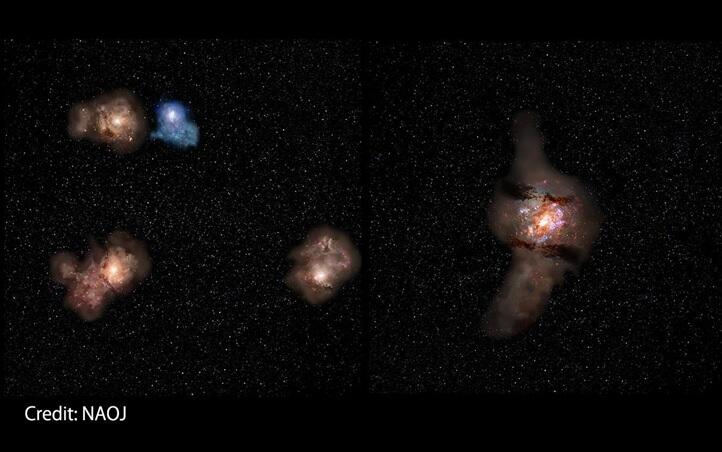An international research team led by Assistant Professor Takuya Hashimoto of the Faculty of Pure and Applied Sciences at the University of Tsukuba and Centro de Astrobiología (CAB) announced that they have successfully captured the 'core region' of the farthest protocluster, located 13.14 billion light-years away and densely populated with galaxies (such as a metropolitan area), via observations using the James Webb Space Telescope (JWST) and the Atacama Large Millimeter/submillimeter Array (ALMA). Evidently, the rapid growth of galaxies occurs due to the clustering of numerous galaxies in a small area. Furthermore, they used simulations to predict the future shape of the metropolitan area, revealing that this metropolitan area will merge into a single, larger galaxy within tens of millions of years. These results were published in the September 13, 2023 issue of The Astrophysical Journal Letters, an international journal.

Provided by Assistant Professor Takuya Hashimoto, National Astronomical Observatory of Japan
A group of more than a hundred galaxies assembled by each other's gravity is called a galaxy cluster and is considered one of the largest structures in the universe. Observations of galaxies relatively close to the Earth have shown that the life and death cycles of individual stars are more rapid in environments where galaxies are crowded together, and such effects are known as 'environmental effects.' However, it is not known since when these 'environmental effects' have existed. To clarify this, it is necessary to observe the ancestors of galaxy clusters shortly after the birth of the universe.
The ancestor of a galaxy cluster is called a protocluster, which is a group of approximately 10 galaxies more than 10 billion light-years away and can be observed by observing distant regions of the universe. However, light and radio waves that travel distances of tens of billions of light-years weaken during their journey, requiring telescopes with a high sensitivity and temporal resolution to observe them.
The research group conducted observations of the core region of the protocluster (A2744-z7p9OD) using JWST and succeeded in detecting the light from ionized oxygen ions from four galaxies in a square region with one side measuring 36,000 light-years, which is equivalent to half of the Milky Way galaxy's radius. The distance of the four galaxies from the Earth was identified as 13.14 billion light-years.
Furthermore, observation data of radio waves emitted by dust, captured through ALMA in this area, was analyzed. As a result, radio waves emitted from dust were detected in three out of the four galaxies. This marks the first instance of dust being detected in a protocluster from such a distant era in the past.
The discovery of abundant dust in galaxies revealed that several first-generation stars within the galaxy have already reached the end of their lifespans, indicating the ongoing growth of the galaxy. It was also shown that the galaxies merged and evolved into larger galaxies within a timescale of tens of millions of years, which is a short time scale for the evolution of the universe.
Hashimoto stated, "I, along with my research group, spent several months analyzing data from JWST, employing various techniques and innovations. This analysis revealed the precise distances of the four galaxies, and I was amazed to discover that they are clustered in a small area, with approximately half the radius of the Milky Way galaxy. In the future, I hope to unveil the appearance of galaxies in the early universe using the combination of JWST and ALMA."
Journal Information
Publication: The Astrophysical Journal Letters
Title: Reionization and the ISM/Stellar Origins with JWST and ALMA (RIOJA): The Core of the Highest-redshift Galaxy Overdensity at z = 7.88 Confirmed by NIRSpec/JWST
DOI: 10.3847/2041-8213/acf57c
This article has been translated by JST with permission from The Science News Ltd. (https://sci-news.co.jp/). Unauthorized reproduction of the article and photographs is prohibited.




